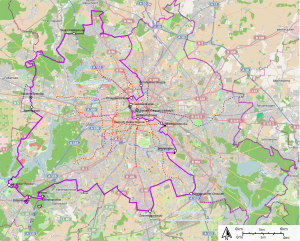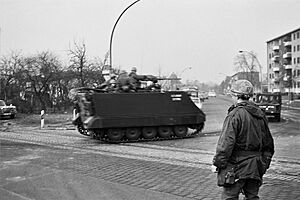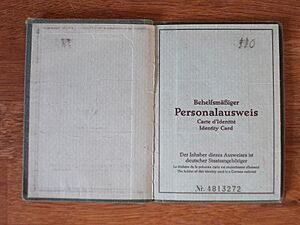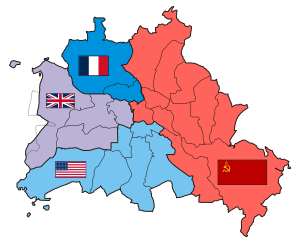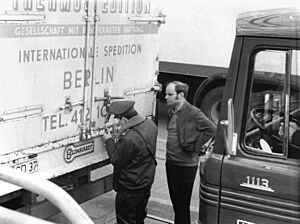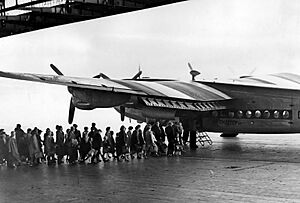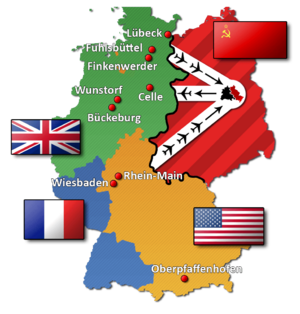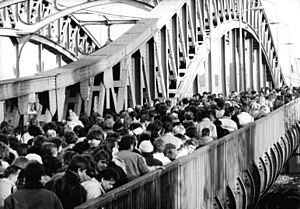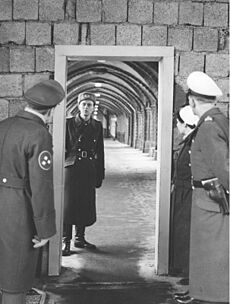West Berlin facts for kids
Quick facts for kids
West Berlin
West-Berlin
Berlin-Ouest Berlin (West) |
|||||||||||
|---|---|---|---|---|---|---|---|---|---|---|---|
| 1948–1990 | |||||||||||
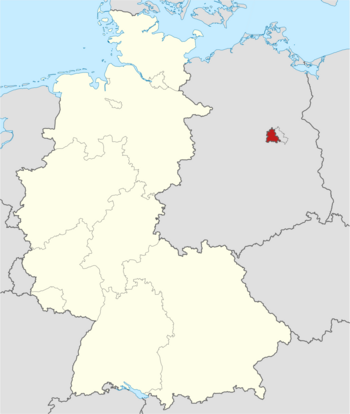
West Berlin (red)
|
|||||||||||
| Status | Western Allies–occupied sectors of Berlin Free city (De facto territory of the Federal Republic of Germany) |
||||||||||
| Official languages | German | ||||||||||
| Governing Mayor | |||||||||||
|
• 1948–1953 (first)
|
Ernst Reuter (SPD) | ||||||||||
|
• 1989–1990 (last)
|
Walter Momper (SPD) | ||||||||||
| Historical era | Cold War | ||||||||||
|
• Soviet-backed coup against the elected government of Berlin
|
November 1948 | ||||||||||
| 3 October 1990 | |||||||||||
| Area | |||||||||||
| 1989 | 479.9 km2 (185.3 sq mi) | ||||||||||
| Population | |||||||||||
|
• 1989
|
2,130,525 | ||||||||||
| Currency | Deutsche Mark (official) United States dollar (also widely used) |
||||||||||
|
|||||||||||
| Today part of | Germany | ||||||||||
West Berlin was a special part of Berlin that existed from 1948 to 1990. It was like an "island" of Western countries inside East Germany during the Cold War. Even though it was surrounded by East Germany, West Berlin was closely connected to West Germany. Most people living there were citizens of West Germany.
West Berlin was controlled by the United States, the United Kingdom, and France. It was a very important symbol during the Cold War, showing the "free world" to people in the East. West Germany helped West Berlin a lot, making it a rich city known for its culture and education. It was the biggest city in Germany during the Cold War, with about two million people.
West Berlin was about 160 kilometers (100 miles) away from the main border of West Germany. You could only reach it by land through special routes. In 1961, the Berlin Wall was built, completely separating West Berlin from East Berlin and East Germany. The Wall came down in 1989, and on October 3, 1990, West and East Berlin reunited. They became the capital of a unified Germany.
Contents
How West Berlin Started
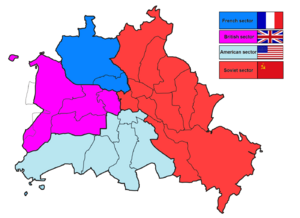
After World War II, Germany was divided into four parts, each controlled by one of the winning countries: the United States, the United Kingdom, the Soviet Union, and France. Berlin, even though it was deep inside the Soviet-controlled area, was also divided into four parts. The Western Allies (US, UK, France) controlled the western parts of the city.
At first, everyone hoped Germany and Berlin would reunite soon. But as the Cold War began, the relationship between the Western Allies and the Soviet Union got worse. In 1948, the Soviets tried to force the Western Allies out of Berlin by blocking all land routes. This was called the Berlin Blockade.
The Western Allies responded with the Berlin Airlift. They flew in food and supplies to West Berlin every day. In May 1949, the Soviets gave up, and the blockade ended. West Berlin remained a separate city.
After the blockade, East Germany started closing its borders in 1952, making West Berlin even more isolated. Phone lines were cut, and roads were blocked. The biggest separation happened in 1961 when the Berlin Wall was built.
West Berlin's Special Rules
West Berlin had a unique legal status. Even though West Germany was formed in 1949, Berlin remained under the control of the Allies. This meant West Berlin wasn't fully a part of West Germany.
West Berliners couldn't vote in West German national elections. Instead, they had representatives who could attend meetings but not vote. However, West Berliners were considered citizens of West Germany. Young men in West Berlin were also excused from military service, which made the city a popular place for young people. This led to a lively youth culture.
The Western Allies had the final say in West Berlin. Any new laws passed by the city had to be approved by the Allied commanders. West Berlin was led by an elected Mayor and Senate, but their power came from the occupying forces.
East Germany and the Soviet Union saw West Berlin differently. They called it an "independent political unit" and didn't recognize it as part of West Germany. On their maps, West Berlin was often shown as a blank space or labeled as a "special political area."
Travel and Identity
West Berliners could get West German passports, but these passports weren't accepted by Eastern Bloc countries. Instead, West Berlin authorities issued "auxiliary identity cards." These cards looked different from West German ones but stated the holder was a German citizen.
From 1968, East Germany required West Berliners and West Germans to get a special transit visa to pass through their territory. These visas were stamped on separate papers, not directly in the identity cards.
West Berlin became a popular place for people from East Germany to escape to. The West German government even paid for flights to West Germany for those who couldn't travel by land.
Names for Berlin
Most people in the West simply called the Western sectors "Berlin." The West German government officially called it "Berlin (West)." The East German government often called it "Westberlin."
East Berlin was officially called "Berlin, Capital of the GDR" by East Germany. Westerners often called it "East Berlin." The different names people used often showed their political views.
After the Berlin Wall was Built

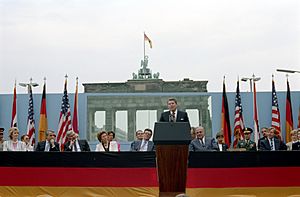
After the Berlin Wall was built in 1961, there were ideas about what to do with West Berlin. One idea, considered by the US, was to trade West Berlin for other parts of East Germany. This never happened.
NATO, a military alliance, also made plans to defend West Berlin if it was attacked.
On June 26, 1963, U.S. President John F. Kennedy visited West Berlin. He gave a famous speech where he said, "Ich bin ein Berliner" (I am a Berliner). This showed America's strong support for the city.
Later, in 1971 and 1972, new agreements helped reduce tensions over West Berlin. It became easier for West Berliners to travel to East Germany.
In 1987, U.S. President Ronald Reagan stood at the Brandenburg Gate and challenged the Soviet leader, Mikhail Gorbachev, saying, "Mr. Gorbachev, tear down this wall!"
On November 9, 1989, the Berlin Wall finally opened. The two parts of the city were physically connected again. On October 3, 1990, East and West Berlin officially reunited and became part of the Federal Republic of Germany.
West Berlin's Areas
West Berlin was made up of several districts, called Bezirke:
In the American sector:
- Neukölln
- Kreuzberg
- Schöneberg
- Steglitz
- Tempelhof
- Zehlendorf
In the British sector:
- Charlottenburg
- Tiergarten
- Wilmersdorf
- Spandau
In the French sector:
- Reinickendorf
- Wedding
Special Border Areas
West Berlin's border followed the old city limits of Berlin. This meant there were some unusual parts, like small areas of West Berlin (called exclaves) that were completely surrounded by East Germany. For example, a part of Berlin-Staaken, which was supposed to be in the British sector, ended up being controlled by the Soviets.
Mail and Phones
West Berlin had its own postal service, called Deutsche Bundespost Berlin. It even issued its own postage stamps until 1990. However, this was mostly symbolic, as it worked just like West Germany's postal service.
West Berlin was also connected to West Germany's phone network. Calls from West Berlin to East Berlin used a short code, but calls from West Germany to East Berlin needed a longer international code. To prevent spying, special microwave towers were built to send phone calls between West Berlin and West Germany.
Getting Around West Berlin and Beyond
West Berliners could always travel to West Germany and other Western countries, except during the Berlin Blockade.
To travel by road or train to West Germany, people had to pass through East Germany. This meant going through East German border checks. West Berliners needed their identity cards, and other travelers needed passports. East Germany charged a fee for a "transit visa" to cross their territory.
There were special highways for transit travel, marked with "Transit" signs. Travelers were not allowed to leave these routes. East German border guards would sometimes check how long it took people to travel, to make sure they weren't stopping to meet East Germans.
East Germany also charged tolls for using their roads.
Trains and Waterways
Trains connected West Berlin to West Germany, but they usually only stopped in West Berlin at the Berlin Zoologischer Garten railway station. These trains did not pick up or drop off passengers within East Germany.
The railways in Berlin, including the S-Bahn (city train network), were run by East Germany's railway company, the Deutsche Reichsbahn. This meant East German railway police could patrol stations in West Berlin. Many West Berliners boycotted the S-Bahn because the money from tickets went to the East German government. Eventually, in 1984, West Berlin's own transport company took over the S-Bahn in West Berlin.
Two waterways were open for freight ships, but only cargo vessels could cross into East German waters. West Berlin also paid East Germany to treat its sewage and dispose of its rubbish, as many facilities were in the East.
Air Travel
Air travel was the only way to get to West Berlin that wasn't controlled by East Germany. Flights were operated by British, French, or U.S. airlines. The West German airline Lufthansa was not allowed to fly to West Berlin. The West German government even helped pay for flights for people who might be arrested if they tried to cross East Germany by land.
Travel Between East and West Berlin
Even though East and West Berlin were separate, people could move freely between them for a long time. However, East German authorities slowly started to cut off connections.
During the Berlin Blockade, the Soviets tried to get West Berliners to buy food in East Berlin. But most West Berliners chose to support the Western Allies instead.
In 1952, East Germany closed its border with West Germany and West Berlin. From then on, West Berliners needed a permit to enter East Germany. However, East Berlin remained open to West Berliners until 1961.
Public transport between East and West Berlin was gradually cut off. Tram lines were interrupted, and train services were changed. The East German government wanted to stop people from escaping to the West.
On August 13, 1961, the East German government built the Berlin Wall. This physically closed off West Berlin from East Berlin and East Germany. All roads, paths, and even sewers leading to West Berlin were blocked. The Wall was built to stop East Germans from leaving.
Westerners could still get visas to enter East Berlin at certain checkpoints. One famous checkpoint was Checkpoint Charlie.

After the Wall was built, West Berlin's Mayor, Willy Brandt, protested. The Brandenburg Gate checkpoint was closed until 1989.
For a while, West Berliners were banned from entering East Berlin. But in 1963, they were allowed to visit again for short periods, especially around holidays. East Germany charged a fee for these visits, which helped them get Western money.
In 1971, a new agreement made it easier for West Berliners to visit East Germany and East Berlin regularly. Visas were easier to get, though East Germany still required visitors to exchange a certain amount of Western money for Eastern money.
Some underground train lines from West Berlin passed through tunnels under East Berlin without stopping. These were called "ghost stations" because they were empty and dark. West Berlin paid East Germany to use these tunnels. One station, Berlin Friedrichstraße railway station, was open for Western trains to stop, allowing passengers to transfer or enter East Berlin.
On November 9, 1989, the borders finally opened, and East Germans and East Berliners could freely enter West Berlin. West Berlin had never restricted their entry. Soon after, West Berliners and West Germans could also enter East Berlin and East Germany freely without charges. Border controls slowly ended in June 1990, just before Germany was reunified.
See also
 In Spanish: Berlín Occidental para niños
In Spanish: Berlín Occidental para niños




